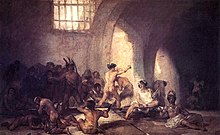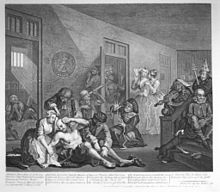A Review of Madness and Civilizationa History of Insanity in the Age of Reason by Michel Foucault
 The Librairie Plon edition | |
| Author | Michel Foucault |
|---|---|
| Original title | Folie et Déraison: Histoire de la folie à 50'âge classique |
| Translator | Richard Howard (abridged edition) Jonathan Irish potato and Jean Khalfa (unabridged edition) |
| Country | France |
| Linguistic communication | French |
| Field of study | Insanity |
| Published |
|
| Media type | Print (Hardcover and Paperback) |
| Pages | 299 (Vintage edition) 725 (unabridged edition) |
| ISBN | 0-679-72110-Ten (Vintage edition) 0-415-27701-ix (entire edition) |
Madness and Civilization: A History of Insanity in the Age of Reason (French: Folie et Déraison: Histoire de la folie à 50'âge classique, 1961) is an examination past Michel Foucault of the evolution of the meaning of madness in the cultures and laws, politics, philosophy, and medicine of Europe—from the Middle Ages until the finish of the 18th century—and a critique of the idea of history and of the historical method.
Although he uses the language of phenomenology to depict the influence of social structures in the history of the Othering of insane people from society, Madness and Civilization is Foucault's philosophic progress from phenomenology toward something like structuralism (a label Foucault himself always adamantly rejected).[1]
Background [edit]
Philosopher Michel Foucault developed Madness and Civilization from his before works in the field of psychology,[i] his personal psychological difficulties, and his professional experiences working in a mental hospital. He wrote the volume betwixt 1955–1959, when he worked cultural-diplomatic and educational posts in Poland and Germany,[2] besides every bit in Sweden as managing director of a French cultural centre at the University of Uppsala.[iii]
Summary [edit]

In the 17th-century Historic period of Reason, insane and socially undesirable people would end at The Madhouse. (Francisco Goya, 1812-1819)
In Madness and Civilization, Foucault traces the cultural evolution of the concept of insanity (madness) in iii phases:
- the Renaissance;
- the Classical Age; and
- the Modernistic era
Renaissance [edit]
In the Renaissance, art portrayed insane people equally possessing wisdom (knowledge of the limits of the earth), whilst literature portrayed the insane every bit people who reveal the distinction between what men are and what men pretend to exist. Renaissance art and literature further depicted insane people every bit intellectually engaged with reasonable people, because their madness represented the mysterious forces of cosmic tragedy.[2] Nonetheless Renaissance intellectualism began to develop an objective manner of thinking about and describing reason and unreason, compared with the subjective descriptions of madness from the Centre Ages.[1]
Classical Age [edit]
At the dawn of the Age of Reason in the 17th century, there occurred "the Nifty Solitude" of insane people in the countries of Europe, the initial direction of insane people was to segregate them to the margins of society, and and then to physically separate them from order past confinement, with other anti-social people (prostitutes, vagrants, blasphemers, et al.) into new institutions, such as the Full general Hospital of Paris.[1] Christian European social club perceived such anti-social people as being in moral error, for having freely called lives of prostitution, vagrancy, blasphemy, unreason, etc. To revert such moral errors, society's new institutions to confine outcast people featured way-of-life regimes equanimous of penalization-and-reward programs meant to compel the inmates to choose to reverse their choices of lifestyle.[1]
The socio-economic forces that promoted the institutional solitude included the legalistic need for an extrajudicial social mechanism with the legal potency to physically separate socially undesirable people from mainstream guild; and for controlling the wages and employment of poor people living in workhouses, whose availability lowered the wages of freeman workers. The conceptual distinction, between the mentally insane and the mentally sane, was a social-construct produced by the practices of the extrajudicial separation of a human from gratuitous society to institutional solitude. In turn, institutional solitude conveniently made insane people bachelor to medical doctors and so first to view madness as a natural object of study, and so as an illness to be cured.[1] [ii]
Modern era [edit]
The Mod era began at the stop of the 18th century, with the creation of medical institutions for confining mentally insane people nether the supervision of medical doctors. Those institutions were production of two cultural motives: (i) the new goal of curing the insane away from poor families; and (two) the old purpose of confining socially undesirable people to protect society. Those 2, distinct social purposes presently were forgotten, and the medical institution became the only identify for the administration of therapeutic treatments for madness. Although nominally more enlightened in scientific and diagnostic perspective, and empathetic in the clinical treatment of insane people, the mod medical institution remained as cruelly decision-making every bit were mediaeval treatments for madness.[i] In the preface to the 1961 edition of Madness and Civilization, Foucault said that:
Modern man no longer communicates with the madman . . . There is no common language, or rather, it no longer exists; the constitution of madness every bit mental illness, at the end of the eighteenth century, bears witness to a rupture in a dialogue, gives the separation every bit already enacted, and expels from the memory all those imperfect words, of no fixed syntax, spoken falteringly, in which the commutation, between madness and reason, was carried out. The linguistic communication of psychiatry, which is a monologue by reason about madness, could only have come into beingness in such a silence.[4]
Reception [edit]

In the critical book, Foucault (1985), the philosopher José Guilherme Merquior said that the value of Madness and Civilization as intellectual history was diminished by errors of fact and of interpretation that undermine Foucault'south thesis — how social forces determine the meanings of madness and society's responses to the mental disorder of the person. That his selective citation of data ignored contradictory, historical evidence of preventive imprisonment and physical cruelty towards insane people during the historical periods when Foucault said gild perceived the mad as wise people — institutional behaviors allowed by the culture of Christian Europeans who considered madness worse than sin. Yet, Merquior said that, like the book Life Confronting Death (1959), by Norman O. Brown, Foucault's book nigh Madness and Civilization is "a call for the liberation of the Dionysian id"; and gave inspiration for Anti-Oedipus: Commercialism and Schizophrenia (1972), by the philosopher Gilles Deleuze and the psychoanalyst Félix Guattari.[5]
In his 1994 essay "Phänomenologie des Krankengeistes" ('Phenomenology of the Sick Spirit'), philosopher Gary Gutting said:[6]
[T]he reactions of professional historians to Foucault's Histoire de la folie [1961] seem, at beginning reading, ambivalent, not to say polarized. There are many acknowledgements of its seminal function, beginning with Robert Mandrou's early review in [the Annales d'Histoire Economique et Sociale], characterizing it as a 'beautiful book' that will exist 'of central importance for our understanding of the Classical period.' Twenty years afterwards, Michael MacDonald confirmed Mandrou'south prophecy: 'Anyone who writes about the history of insanity in early modern Europe must travel in the spreading wake of Michael Foucault's famous book, Madness and Civilisation.'
Later endorsements included Jan Goldstein, who said, "For both their empirical content and their powerful theoretical perspectives, the works of Michel Foucault occupy a special and central place in the historiography of psychiatry;" and Roy Porter, "Time has proved Madness and Civilization [to be by] far the most penetrating work ever written on the history of madness." However, despite Foucault being herald of 'the new cultural history', there was much criticism.[6]
In Psychoanalysis and Male Homosexuality (1995), Kenneth Lewes said that Madness and Civilisation is an example of the "critique of the institutions of psychiatry and psychoanalysis" that occurred as part of the "full general upheaval of values in the 1960s." That the history Foucault presents in Madness and Civilization is similar to, but more profound than The Myth of Mental Illness (1961) by Thomas Szasz.[vii]
Run across also [edit]
- Anti-psychiatry
- Cogito and the History of Madness
- The Archæology of Knowledge
Notes [edit]
- ^ Foucault had a bachelor's degree in psychology (1949) and a diploma in psychopathology (1952)
References [edit]
- ^ a b c d e f Khalfa J. in Foucault M. (2009). "Introduction". History of Madness. NY: Routledge. pp. xiiv–xxv. ISBN978-0-415-47726-0.
{{cite volume}}: CS1 maint: uses authors parameter (link) - ^ a b c Gutting, Gary. 2013. "Michel Foucault." The Stanford Encyclopedia of Philosophy (Summer 2013 ed.), edited past Eastward. North. Zalta.
- ^ Macey, David. 2004. Michel Foucault. Reaktion Books, p. 46. ISBN 978-1-86189-226-3
- ^ Foucault Thou. (2009). "Preface to the 1961 edition". History of Madness. Translated by Khalfa J. NY: Routledge. pp. xxvii–xxxix. ISBN978-0-415-47726-0.
- ^ Merquior, José Guilherme. Foucault (1985) Fontana Printing ISBN 0-00-686226-8
- ^ a b Gutting, Gary (1994), "Michel Foucault's "Phänomenologie des Krankengeistes"", in Micale, Mark. S.; Porter, Roy (eds.), Discovering the History of Psychiatry, Oxford University Printing, pp. 331–347, ISBN9780195077391 . Quote from p. 331.
- ^ Lewes, Kenneth (1995). Psychoanalysis and Male Homosexuality. Northvale, New Jersey: Jason Aronson Inc. p. 201. ISBN1-56821-484-seven.
External links [edit]
- Some images and paintings that appear in the book
Source: https://en.wikipedia.org/wiki/Madness_and_Civilization
0 Response to "A Review of Madness and Civilizationa History of Insanity in the Age of Reason by Michel Foucault"
Enregistrer un commentaire